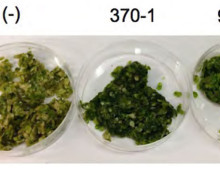Climate change in the Arctic is progressing rapidly, thawing large areas of permafrost that contain nearly half of the world’s soil organic carbon. Once thawed, this soil carbon is first to be converted to dissolved organic carbon, which is then oxidized by microbes and sunlight to carbon dioxide. The conversion of this carbon pool to…
Novel Proteins with Metal Sensing Capabilities
Microbial metal and radionuclide reduction is central to a wide variety of processes, including biogeochemical metal cycling, hazardous organic matter degradation, and electricity generation in microbial fuel cells. Despite the potential benefit as alternative strategies for energy generation and radionuclide remediation, the molecular mechanism of microbial metal and radionuclide reduction remains poorly understood. Bacteria such…
Phosphorus Response in Plant-Microbe Symbioses
While plant-microbe symbioses play critical roles in enhancing nutrient acquisition and ecosystem productivity, little information is available on the complex metabolic and signaling pathways that mediate such responses. In this project, researchers specifically plan to study the influences of ectomycorrhizal (ECM) fungi and plant growth promoting bacteria (PGPB) on the phosphorus starvation response in aspen…
Studying the Columbia River SIZ
The zone of groundwater-surface water mixing, known as the Subsurface Interaction Zone (SIZ), is a critical and ubiquitous domain at the groundwater-surface water interface that strongly influences carbon and nitrogen cycling and regulates contaminant releases to surface waters. Researchers want to understand how groundwater-surface water mixing dynamics impact microbial communities. For this project, the work…
Methanogen Models to Maximize Biofuel Production
Methanogens—anaerobic microbes that perform the final step of biomass degradation in the carbon cycle—convert carbon dioxide or monoxide, acetate, methanol, methyl-sulfides and methylamines into methane as part of their core metabolic system. They represent an integral piece of the global carbon cycle as an estimated 350 million tons of methane are produced yearly by methanogens….
Understanding the Duckweed Microbiome
Duckweed is a family of aquatic plants that are capable of quickly converting wastewater into an easily harvestable biomass with low lignin content. Recent research has demonstrated the potential of duckweed to be used as a sustainable source of renewable biomass for biofuel. While scaling-up duckweed farming does not require the use of arable land…
Pine-Suillus Symbiosis Study
Ectomycorrhizal fungi (EMF) are emerging as a model system for understanding microbial community dynamics and the linkages between microbial communities and ecosystem function. EMF provide their plant hosts with nutrients such as nitrogen, phosphorous, and water, in exchange for fixed carbon. Trade between the two partners constitutes a significant ecosystem flux in resources between plant…
A Permafrost Thaw Chronosequence in Sweden
Permafrost is a key globally important ecosystem, storing massive amounts of carbon across a large area. Permafrost-associated soils cover nearly a quarter of the terrestrial land surface, contain more than a third of the world’s soil carbon, and are thawing due to climate change. The fate of the stored carbon is a key unknown in…
Model for Methane and Microbial Metabolism
Methane hydrates are pockets of methane trapped inside a solid structure of water and are often found in ocean floor sediments. Marine continental margin sediments that bear these methane hydrates are estimated to contain up to 2,000 billion metric tons of methane. Anaerobic methanotrophic archaea and sulfate-reducing bacteria (ANME-SRB consortia) account for the oxidation of…
Testing synthesized genes in A. niger
Aspergillus niger is used in industry for the production of enzymes for biomass degradation and other applications. It is also a useful host for expressing glycoside hydrolase (GH) genes from bacteria that have valuable properties. However, researchers do not fully understand the factors that provide high titer production of heterologous enzymes in fungal hosts. The…

